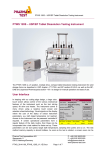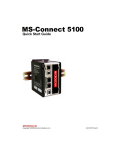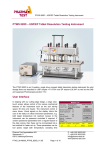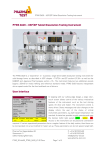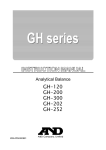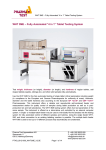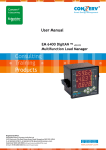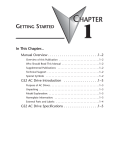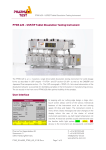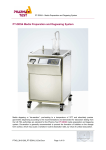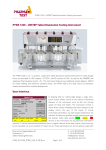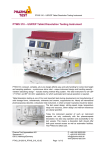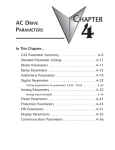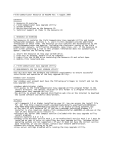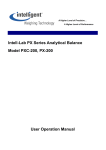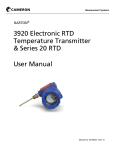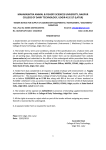Download PTB 420 – Automated Tablet Testing Instrument
Transcript
PTB 420 – Automated Tablet Testing Instrument PTB 420 – Automated Tablet Testing Instrument The automated tablet testing instrument PTB 420 is a dual test mode instrument to determine the diameter, thickness and hardness of tablets. The instrument is made in strict compliance with the EP <2.9.8> and USP <1217> Pharmacopoeia. Prior to testing the hardness of the tablet the PTB 420 can measure sample thickness (or height) and diameter (or length). The thickness is detected automatically by an optical system. The samples are automatically positioned by means of the patented movable alignment jaws. The behaviour of the jaw’s movement is adjustable to accommodate many different shapes of tablets and oblongs. The instrument can be set to either linear force or linear speed increase mode for the tablet hardness test. Furthermore, PTB 420 allows the connection of a Mettler-Toledo or Sartorius analytical balance to measure the weight of the samples as well. PTB 420 offer two modes for the weight measurement: either weigh each sample individually, before placing them into the tablet magazine or weigh all samples together Pharma Test Apparatebau AG Siemensstr. 5 63512 Hainburg/Germany PTAG_29-04000_PTB420_V1.1E P: +49 6182 9532 600 F: +49 6182 9532 650 [email protected] www.pharma-test.com Page 1 of 11 PTB 420 – Automated Tablet Testing Instrument and calculate the average weight. PTB 420 features a large, back-lit color LCD. Menu navigation is done by use of a click wheel similar to the ones used in many car navigation systems. This allows the user to rapidly scroll through the menus to make his selections. Quickly create methods by entering the nominal test information for thickness, diameter, hardness and weight via the alpha-numerical keyboard and select the unit to measure (mm/in, Kp/N/Sc). It is also possible to use the quick test functionality to work without creating a method first and without entering any nominal values. When creating a method, it is also possible to disable certain measurements, for example to only test the hardness of a tablet. The angle of the operation panel can be adjusted freely to guarantee optimal visibility, whether the user is sitting in front of the instrument or operating it from a standing position. To perform a test with PTB 420, either insert the samples into the tablet magazine or drop the individual samples into the unique sample positioning station for automated correct alignment inside the combined thickness, diameter and hardness test station. A class 1 laser beam is used for the touch free measurement of the sample thickness. The beam is used to illuminate a CCD-sensor on the other side of the measurement area. The sample is scanned by the laser beam while simultaneously being moved in front of the CCD-sensor by the moving sample dish. The Height adjustment screen, enlarged CCD height of the sample can be determined form the sample’s shadow on the CCD-sensor. Thereafter the image on the left, 1:1 image on the right side sample is automatically moved towards the force jaw to measure the diameter and finally the hardness by breaking it. Once the test is finished and the sample is broken, the sample dish moves backwards to drop the sample fragments into the removable waste container. The results are immediately displayed and may be printed on a connected printer. The print-out includes each individual result as well as product information, date, time, user, instrument serial number and statistics. PTAG_29-04000_PTB420_V1.1E Page 2 of 11 PTB 420 – Automated Tablet Testing Instrument Operation Principle of the Hardness Measurement The current monographs of the USP and EP Pharmacopoeia define how a tablet hardness testing instrument should work, but without establishing data of how to increase the applied force and when to detect a sample to be broken. This often causes problems when trying to compare results of the same tablet measured with instruments from different manufacturers. The hardness result is directly influenced by the contact speed and force increase rate of testing instrument. A faster operated test jaw means a lower reproducibility and often higher absolute results. In order to offer the possibility to select an operating mode which will offer you similar results to other instruments you may already use, PTB 420 allows to set the force mode by selecting between linear force increase or linear speed increase and the set the force rate. When the instrument detects that the sample has been touched, it switches to the measuring mode and starts to increase the force applied to the sample. Another adjustable parameter the break detection force to test softer samples as well as gel capsules. Often, samples such as soft gel capsules do not break but become smaller in diameter (deformation). To increase the sensitivity of the instrument and to get a result without just squashing the sample, the total testing distance of the jaw after contact with the sample can be programmed. Which Force Mode to Select? Since more than 10 years ago all Pharma Test tablet hardness testing instruments offer the possibility to select either linear force or linear speed increase. Linear force increase offers the most accurate control, as the rate of increase is directly controlled by the electronic load cell used to read the force. Also it is quite simple to validate the correct and linear operation, as a tablet with, for example 100N hardness, will be broken within 5 seconds, when 20N/s had been set as force increase rate. Linear speed increase can also be used; here the driving speed of the stepper motor is kept linear. Actually, as long as the touching force is kept low, there is not too much difference in the results between the two modes, but validation of this mode is reasonably difficult and requires specific equipment. In general results obtained with the linear speed increase mode are less PTB 420 mechanics showing the measuring reproducible than the ones with linear force increase area, force sensor and alignment jaws mode. Therefore Pharma Test recommends using linear force increase. The test of "soft" tablets often requires an increase of the standard force setting, otherwise the sample gets deformed only but does not break. We will continue to offer both modes of operation in order to offer the possibility of comparing results of different instruments by setting the same parameters of operation. PTAG_29-04000_PTB420_V1.1E Page 3 of 11 PTB 420 – Automated Tablet Testing Instrument Optional Equipment The optional tablet transport magazine holds 10 samples, with a maximal diameter of 22mm and a maximum width of 30mm. The magazine is connected to the PTB 420 instrument by means of a magnetic coupling which is connected to the drive inside the PTB 420. The transport belt moves forward to drop one sample directly into the alignment jaws in the testing station of PTB 420. Once the test has finished and the broken sample is released into the waste container, the next sample is supplied automatically. The magazine can be refilled at any time to allow the testing of larger batches in one test run. As the tablet magazine can easily be removed from the PTB 420, it may be used to collect samples directly at a tablet press. In this case it is possible to use several magazines, one for each tablet press, for example. The PTB 420 features a RS232 interface to connect a Mettler-Toledo or Sartorius analytical balance of 0.1mg accuracy. This way it is possible to test either the individual weight or average weight of all samples prior to the test of the physical parameters of thickness, diameter and hardness. The samples are placed manually from the balance either directly into the testing station of PTB 420 or into the tablet magazine. PTAG_29-04000_PTB420_V1.1E Page 4 of 11 PTB 420 – Automated Tablet Testing Instrument Example Print-Outs -----------------------------------------------------------------------Pharma Test Tablet Testing System PTB420 Ver. 01.00 Serial No. 19075 -----------------------------------------------------------------------Department: PTAG User: ADMINISTRATOR -----------------------------------------------------------------------* TEST REPORT * Print Date: 28.01.2014 Time: 13:03 -----------------------------------------------------------------------Product: Placebo Batch No. 1234ABCD Procedure: Lin. Force Setting: 20.0N/s -----------------------------------------------------------------------No. Weight / g Thickness / mm Diameter / mm Hardness / N -----------------------------------------------------------------------1 0.5190 3.88 9.03 62.1 2 0.5231 3.87 9.02 64.4 +T1 3 0.5149 3.85 9.03 61.3 4 0.5189 3.85 8.98 56.8 -T1 5 0.5199 3.86 9.00 58.5 6 0.5172 3.88 9.01 60.2 7 0.5174 3.86 8.98 63.9 +T1 8 0.5163 3.85 9.01 60.3 9 0.5241 3.89 8.99 53.7 -T2 10 0.5212 3.88 9.01 61.0 -----------------------------------------------------------------------* Statistics * -----------------------------------------------------------------------Range Weight: n Thickness: n Diameter: n Hardness: n -----------------------------------------------------------------------+ I 5.0 %: 0 5.0 %: 0 5.0 %: 0 20.0 %: 0 +T2 3.0 %: 0 3.0 %: 0 3.0 %: 0 10.0 %: 0 +T1 1.0 %: 0 1.0 %: 0 1.0 %: 0 5.0 %: 2 nominal 0.5200 g: 10 3.8mm: 10 9.0mm: 10 60.0 N: 6 -T1 1.0 %: 0 5.0 %: 0 5.0 %: 0 5.0 %: 1 -T2 3.0 %: 0 3.0 %: 0 3.0 %: 0 10.0 %: 1 - I 5.0 %: 0 5.0 %: 0 5.0 %: 0 20.0 %: 0 -----------------------------------------------------------------------val./total 10/10 10/10 10/10 10/10 -----------------------------------------------------------------------Weight / g Thickness / mm Diameter / mm Hardness / N -----------------------------------------------------------------------min / max 0.5149/0.5241 3.85 / 3.89 8.98 / 9.03 53.7 / 64.4 max – min 0.0092 0.040 0.051 10.70 average 0.5192 3.867 9.005 60.22 SD (av.) 0.0029 0.015 0.018 3.22 SD (nom.) 0.0029 0.015 0.019 3.22 -----------------------------------------------------------------------Performed by: ADMINISTRATOR Date: 28.01.2014 Confirmed by: ..................... Date: 28.01.2014 Approved by: ..................... Date: 28.01.2014 Time: 13:03 -----------------------------------------------------------------------Page 1 Example Result Report Print-Out PTAG_29-04000_PTB420_V1.1E Page 5 of 11 PTB 420 – Automated Tablet Testing Instrument -----------------------------------------------------------------------Pharma Test Tablet Testing System PTB420 Ver. 01.00 Serial No. 19075 -----------------------------------------------------------------------Department: PTAG User: ADMINISTRATOR -----------------------------------------------------------------------* CALIBRATION REPORT * Print Date: 28.01.2014 Time: 15:16 -----------------------------------------------------------------------Hardness Calibration, Static Measurement of Reference Weights -----------------------------------------------------------------------Specification Setting Range ------------------------- --------------- ---------------------------Zero Offset/Digits (0 kg) 8609 7200 ... 9200 ------------------------- --------------------------------------------Newton/Digit, max. 300 N 0.00560 0.00506 ... 0.00613 -----------------------------------------------------------------------Measurements Weight / kg Range / kg ------------------------- --------------- ---------------------------Ref. Weight 15 kg (1/5): 15.02 14.90 ... 15.10 Ref. Weight 15 kg (2/5): 15.01 14.90 ... 15.10 Ref. Weight 15 kg (3/5): 15.02 14.90 ... 15.10 Ref. Weight 15 kg (4/5): 15.02 14.90 ... 15.10 Ref. Weight 15 kg (5/5): 15.00 14.90 ... 15.10 ------------------------- --------------------------------------------Ref. Weight 15 kg (avg.): 15.01 14.90 ... 15.10 -----------------------------------------------------------------------Performed by: ADMINISTRATOR Date: 28.01.2014 Confirmed by: ..................... Date: 28.01.2014 Approved by: ..................... Date: 28.01.2014 Time: 15:16 -----------------------------------------------------------------------Page 1 Example Hardness Calibration Report PTAG_29-04000_PTB420_V1.1E Page 6 of 11 PTB 420 – Automated Tablet Testing Instrument Example Print-Out of Force Curve PTAG_29-04000_PTB420_V1.1E Page 7 of 11 PTB 420 – Automated Tablet Testing Instrument Calibration and Adjustment The current USP Pharmacopeia requires the force sensor of a tablet hardness testing instrument to be calibrated periodically over the complete measuring range (or the range used for measuring samples) with a precision of 1N. All Pharma Test tablet hardness testing instrument can be statically calibrated over the complete measuring range by the use of different traceable counterweights. All instruments support the checking of at least three different points during calibration to prove the linearity of the force sensor. Furthermore, Pharma Test offers the PT-MT3 magnetic tablets to calibrate the breakpoint detection of the whole tablet hardness testing instrument (force sensor and mechanics of the instrument). All Pharma Test tablet hardness testing instruments are fully compliant to the requirements of the current USP Pharmacopeia. PT-MT3 Magnetic Test Tablet PTB 420 features an access controlled calibration and adjustment program for the three testing stations. For the thickness and diameter station, certified reference blocks are used for both calibration and adjustment. Weight sets are used to calibrate and adjust the force sensor (load cell) of the instrument over the complete measuring range. For the two point adjustment (zero and reference) of the load cell inside the hardness station a certified reference weight of 10 kg is used. For validation purposes the use 5 up to 50kg certified weights is recommended. The latest calibration and adjustment results are stored on the instrument and can be printed and signed. To prove the linearity of the built-in load cell during a hardness test, the operator can program a print-out of the force curve recorded during a test. This will show the linear increase of the adjusted force mode. PTB-CAL15 5, 10, 15kg adjustable weight set PTAG_29-04000_PTB420_V1.1E Page 8 of 11 PTB 420 – Automated Tablet Testing Instrument Advantages Some of the highlights the PTB 420 offers are: Automated positioning of samples in the testing area by unique alignment jaws Touch-less measurement of sample thickness Test up to 10 samples fully automatically by using the tablet magazine (optional); magazine can be refilled at all times Sophisticated user and method management system included Quick start functionality to start testing with minimal preparation Quick menu navigation by using a large color LCD and a click wheel Select either linear force or linear speed increase (dual mode selection) Entry of time and date Enter a 12 digit batch number Dual point adjustment of the load cell for the hardness test station Multiple point validation (calibration) Hardness testing in compliance with the EP <2.9.8> and USP <1217> Pharmacopoeia IQ/OQ documents included free of charge Features The main features of the PTB 420 are: Tablet hardness testing in full compliance to USP <1217> and EP <2.9.8> Pharmacopeia 4 results of the same sample: thickness, diameter, hardness and weight (via connected external analytical balance) Dual force mode instrument with linear speed increase and linear force increase modes Steppless adjustment of the linear force or speed increase rate Document all results on external printer Multiple point validation procedure for all measurement stations built-in Programmable print-out of force increase curve Standard Scope of Supply The PTB 420 comes ready to use with the following standard scope of supply: PTB 420 instrument A set of 3, 5 and 10mm reference blocks Comprehensive documentation folder including: User manual QC/DQ testing certificate IQ documentation OQ documentation Conformity Declaration CE/EMC Declaration Instrument logbook PTAG_29-04000_PTB420_V1.1E Page 9 of 11 PTB 420 – Automated Tablet Testing Instrument Options In addition to the standard scope of supply Pharma Test offers a broad range of accessories and options including: Tablet magazine for 10 samples Extended hardness range of up to 550N (PTB 420-500 model) Adapter to connect USB PCL5 printers PTAG_29-04000_PTB420_V1.1E Page 10 of 11 PTB 420 – Automated Tablet Testing Instrument Technical Data Parameter Specification Hardness Testing Range 2.0 – 300.0N (optional 5.0 – 500.0N) Hardness Accuracy Better than 1N Thickness Testing Range 2.00 – 12.00mm Thickness Accuracy Better than ±0.05mm Diameter Testing Range 2.00 – 30.00mm Diameter Accuracy Better than ±0.05mm Weight Measurement By connected, external Mettler-Toledo or Sartorius balance (balance not included in standard supply scope) Weight Testing Range 0.0001g – 99.9999g Measuring Units Thickness and diameter selectable between millimeter (mm) and inches (IN) Hardness selectable between Newton (N), Kilopond (kp) and Strong Cobb (Sc) Force Mode Selectable between linear force increase and linear speed increase Force Rate 5 – 200N/sec. (linear force increase) or 5 – 250mm/Min. (linear speed increase) Display Back-lit color LCD Keyboard Alpha-numeric keypad and click wheel Feeder Tablet magazine for 10 samples available (option) Laser Type Class 1 Interface RS232 serial port to connect a Mettler-Toledo or Sartorius analytical balance Parallel port for printer connection USB port for PC connection USB port for firmware updates Instrument Housing Stainless steel (304) to meet GLP requirements Power 110/230 Volt, 50/60 Hz Instrument Dimensions Approx. 31cm x 43cm x 30cm (D x W x H) Packaging Dimensions Approx. 34cm x 68cm x 36cm (D x W x H) Net Weight Approx. 14kg Gross Weight Approx. 19kg Certification All components certified to USP / EP requirements CE / EMC Certification All CE / EMC Certification provided Validation All IQ & OQ documents included We reserve the right to make technical changes without any prior notice. PTAG_29-04000_PTB420_V1.1E Page 11 of 11













